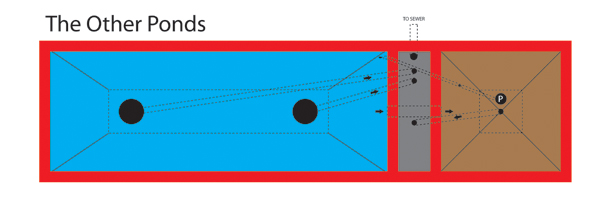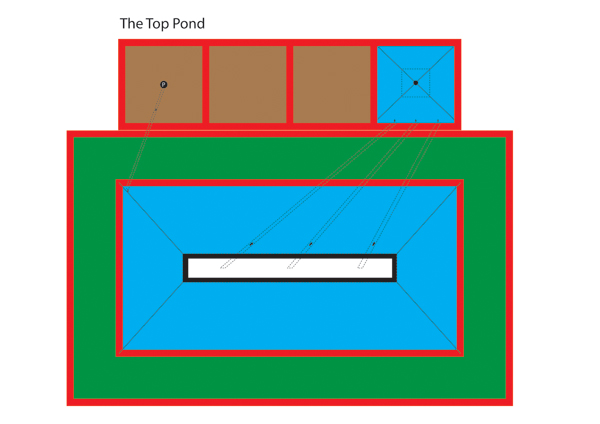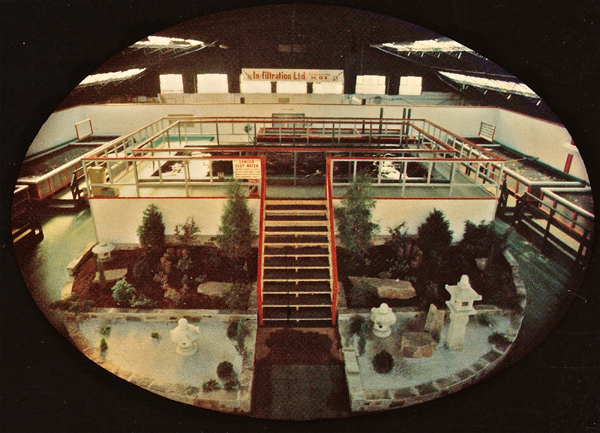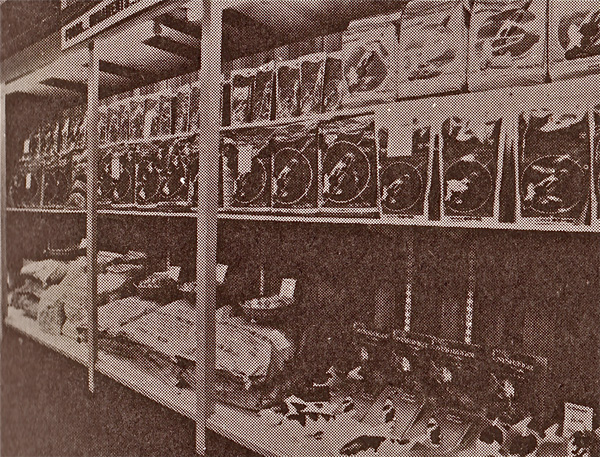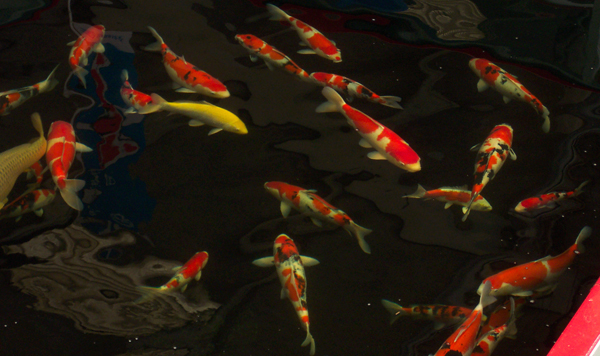Regarding the ‘TOP POND’ – that’s what it later became to be known by to thousands of Koi nuts from all over the world who ventured into Infiltration Ltd. at Golborne.
On one early evening in June 1981 I still recall driving some five miles from my home to Rawtenstall and the house where Barry and Linda Price had just set up their Koi business that they had named Valley Aquatics. My local council had given me the warning I had only six months to continue being a Koi dealer trading from my home address and so I had just agreed on the lease of Unit 12, Millingford Industrial Estate at Golborne. I desperately needed to build some ponds inside the unit where I planned to open ‘Infiltration Ltd – Exclusively Koi’.
It was a wild card at the time; there were no such things as ‘Koi-only’ dealers anywhere in the UK. In view of this, I had no idea if the business was to take off or become an instant and complete disaster so I decided that the ponds I would build needed be transportable to other locations or possibly be sold elsewhere if failure did come about. At the time, the thought of building concrete ponds never even crossed my mind.
I gave the matter some considerable thought and came up with a few pages of line drawings after deciding upon having the pond outer structures built with box section steel frames and lined internally with marine plywood.
Barry Price always was a ‘doer’ of this world and he did just about everything no matter how impossible it seemed to people like myself. Barry looked at my plans carefully, his first remark came out after he pointed to the pond bases and asked – ‘What are these for then?’ I told him they were bottom drains that would supply water to the standpipes for removal to the main waste sewers.
He just looked at me puzzled and then shook his head.
After a few more minutes studying the plans and after a few more attempts to dissuade me from the bottom drains he had made his decisions.
‘Reight’ said Barry in his Lancashire brogue, ‘I’ll build ‘em out o’ two inch box section steel and line ‘em wi’ half inch marine ply. Ah’m tellin’ you lad – they’ll cost you a bloody fortune, do you know how much steel is needed fer this lot?’
There were five ponds of equal size, later to be known as ‘the side ponds’ which would be viewed from a low staging at the front and one giant structure that was to stand in the centre of the building and needed to be be accessed by some steps in view of the depth. This giant structure had a three feet wide walkway all around it that was to be made separately and bolted on to the main frame after delivery. Below the walkway it was to double up as tall, glass-fronted and illuminated display shelving for Koi dry goods that I planned to stock.
The journey from Barry’s business to Golborne was just over 33 miles and I asked him if he planned to build them in sections and weld them together on site. Barry shook his head and said – ‘You just leave ‘bloody build and transport to me, I’m building ‘em ‘ere complete, when I drop ‘em off with you, they’ll be ready to line ‘em with whatever fancy stuff you’re thinking of.’
The outer dimensions of the big structure were a little over seven feet tall by twelve feet wide and twenty-four feet long! I mentioned this as a reminder to Barry who replied – ‘Easy, I’ll stand it on the twenty-four foot run on the seven foot dimension and strap it to the flat-bed.’ I thought of the weight of this twelve-foot tall structure on a transporter and decided not to mention anything – when Barry had made his mind up it was final.
‘Any idea how long they’ll take?’ said I. ‘Depends on how much cash you ‘ave and I want half up front before I even make a phone call t’ order ‘t steel.’
I paid him a small fortune there and then whilst Linda opened a bottle of red.
If I recall correctly, Barry delivered all six ponds inside six weeks and that must have been a mammoth task, I’ll never forget watching the large pond being craned off the transporter in the yard outside of my unit.
This is a plan of one of the five side ponds, the pond and the filter areas were waterproofed with tailored liners that fitted perfectly and were secured at the surface underneath the fitted wooden coping which also served as a clamp. The discharge box was fabricated in UPVC to take two three inch lines from the pond drains and one three inch line from the filter base, in all it held three three-inch ‘O’ ring standpipes and the waste outlet was then connected to the main sewers.
The legs of these ponds allowed us just enough room to get under them in order to fit the bottom drains. In those days they were considered to be outrageous, revolutionary and totally unnecessary. However making a perfect seal to the liners and the wood structure took some weeks of frustration before we eventually found the secret to it all.
The ponds were only three feet at the deepest part and the slope from the walls to the flat base area was very sharp at a 45-degree angle. The filter box was square and shaped in the same way; a three-inch tube supplied water by gravity from pond to filter base by way of a 6” side feed.
Bearing in mind we only had sharp Canterbury Spar gravel as a filter media and needed a 6-inch deep bed for water to come up through it; the weight of this bed was significant and the liner really wasn’t meant to handle all this. Timber support frames were then made with a perforated UPVC sheet fixed to the top and this sat on the wall where the slope to the drain fell inwards. We carefully added the gravel scoop by scoop half-expecting the increased weight to perforate the liner at any moment but thankfully it never happened. A submersible Dab Nova pump was placed centrally atop the gravel and filtered water was returned to the pond via a 1.5” venturi fitting.
A wooden two-step staging was fitted to the front of the pond to allow good access for visitors before the copings were painted later in pillar-box red. Once again, no one had seen any such system like this ever before; in the ensuing years many copied this design for their own garden ponds.
Alas, the ‘top pond’ was nowhere near as easy to install and waterproof.
Firstly it had to rest on the floor because of the estimated weight when filled and so we had a central drain channel on the base initially as shown in the plan.
The four filters were six feet square and, being gravity-fed, were also 6.5 feet deep – as was the pond.
Again, the pond was fitted with a tailored butyl liner that was also made to fit inside the central drain channel and this was relatively easy to do with six guys although the long, flat top cover shown in white had to be dropped into place after the pond was filled for the first time. This involved locking the doors to the unit, stripping down to our underpants and diving down to get the beast located properly.
It was not possible to line the filters with butyl, as six-inch pipelines were needed to connect the four units and bolt-on flanged fittings were both fiddly and costly; in view of this we had the filter structures lined with 5mm polypropylene sheet which was cut to size and welded into shape. Timber support frames were made for the gravel media and the drains to each of the filters were in 3” bore tube then stopped by 3” ball valves. At that time I had no idea of the follies of linking multiple pond drain lines into a common box and so three four-inch feeds were used to link the central channel of the pond to the first filter chamber.
I do not recall how long it took us from delivery of the units to getting them all watertight and finished but it certainly was not a speedy job. On the other hand it was a learning curve that stood me very well for the future after the many mistakes I made along the way had to be rectified.
I opened for business in May 1982 and this is the only remaining shot I have of the finished unit, which was taken in the winter of ’82. The five ‘side ponds’ can be seen with their walkways in front of them with the specified safety rails behind. Even now, I still cannot remember seeing a Koi outlet anywhere in the world since then that was as impressive as this was all those years ago.
But I do recall the huge sign that greeted everyone who walked into the building that read
‘ABANDON HOPE ALL YE WHO ENTER’
As mentioned earlier, the walkway allowed visitors to walk all around the pond; the filters are behind the pond but cannot be seen in this shot. The glass display cases for the dry goods are to the left and right of the pond and this is the only shot I have of one side.
To those readers new to the hobby today, I assure you, this Koi outlet was the only one of its kind in the world when being built back in late 1981 and a business venture that few would have even considered, that is – apart from Waddy, the erstwhile Koi dealer and ‘would be Infiltrator’ to the aquatic establishment of the day!
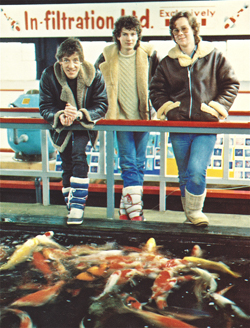 This is quite a well-known shot also taken in the winter of ’82. By then Howard Scott (centre) and Bill McGurk (right) were working with me full time.
This is quite a well-known shot also taken in the winter of ’82. By then Howard Scott (centre) and Bill McGurk (right) were working with me full time.
The moon boots and flying jackets were not stipulated forms of work wear, wintertime in the unit could be very cold indeed and we had all learned well from the savage winter of ’81.
The ‘Top Pond’ was modified a number of times throughout its life and, in 1990 the mammoth was moved by an ‘Iron Fairy’ crane into the adjoining unit 13 that I had also taken a lease on in 1985.
When installed in unit 13, the liner was removed and the marine plywood laminated with glass fibre after concreting three modified standard bottom drains into the base.
The ancient filter system had been re-vamped with upward-flow filter mat cartridges in 1985 but now was broken up and replaced with a GRP ‘9154’ four-chamber vortex system with the three 4-inch bottom drain lines entering the first unit. We made many attempts at regulating and controlling the flow in each of the lines by fitting 4” ball valves and experimenting with part-closing the shortest line that delivered much of the entry water but, until I came up with the ‘one drain to one filter to one pump’ principle in ’91, it never really could be termed as satisfactory.
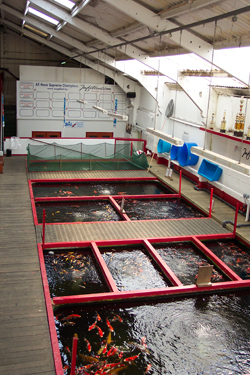 This shot shows the ponds in unit 13 which were built in 1985 after I had brought filter mat and aeration into the UK.
This shot shows the ponds in unit 13 which were built in 1985 after I had brought filter mat and aeration into the UK.
These ponds all used aerated filter mat cartridges in the filter chambers and ran non-stop until the close in 2007. The system was always known as ‘The Trade Ponds’ because they were intended to be there for our many trade buyers who needed volume purchases of Koi for re-sale back then.
The bottom drains in all the ponds and the drains to all the filter chambers were in 4” bore and taken to standpipes in a long discharge box that ran the entire length of the total system.
As an aside, the timber decking seen in the shot was ‘rescued’ from the floorboards of a mill on the same site as our units, which was being finally demolished. It was solid mahogany – ‘proper timber’ – and must have cost a small fortune when the mill was built.
The ‘Top Pond’ always carried our best and most expensive Koi. In truth it ran from early 1982 to late 2007 and I would not dare to even consider the total value of the Koi that spent some of their time in this system. By the time the end came around, the steel support legs were rusting badly but it still stood as a proud testament to Barry’s ‘belt and braces’ workmanship.
There is a valid reason as to why I have documented this famous Koi pond today in 2010 and it is because I have had some time to reflect upon many things over recent months.
Of course I have no actual figures to substantiate the following text but I do consider it all to be as accurate as memory allows.
Whereas there were many other ponds built and running throughout the two buildings for the 25 years at Infiltration in Golborne, these were built to house cheaper Koi in smaller sizes whilst the ‘Top Pond’ contained Koi for serious collectors and I was always well-aware that less than 10% of the visitors who entered my shop could afford to buy the Koi on display in the ‘Top Pond’.
However, many Koi in that pond found buyers who later entered them into Koi shows where they took the coveted Supreme Champion awards, not only in the UK but in other shows held in countries such as Holland, South Africa and the USA.
We are all aware of ‘hindsight’ and the inability to ‘put an old head on young shoulders’ but having thought long and hard about things of late, I have come to this firm conclusion.
That ‘Top Pond’ was the ONLY pond that kept my total KOI sales profitable.
90% of the total PROFIT generated by 25 years of Koi sales at Infiltration came from ‘The Top Pond’.
If this is the case, and I do believe it IS the case – then why did I build, staff, stock and run the many ‘other ponds’ at Golborne?
 Was it to put on a display showing the various sizes/ages of Koi? –
Was it to put on a display showing the various sizes/ages of Koi? –
 Were the ponds built to show Koi in lesser qualities and cheaper price bands? –
Were the ponds built to show Koi in lesser qualities and cheaper price bands? –
 Was it to make the shop ‘look impressive and busy’? –
Was it to make the shop ‘look impressive and busy’? –
 Was it in the hope the shop would sell more dry goods? –
Was it in the hope the shop would sell more dry goods? –
 Did the cheaper quality Koi on display in the other ponds help to sell the more expensive Koi in the ‘Top Pond’? –
Did the cheaper quality Koi on display in the other ponds help to sell the more expensive Koi in the ‘Top Pond’? –
 Definitely not, that never happened even once.
Definitely not, that never happened even once.
These ‘other ponds’ at Golborne all needed building, maintaining, stocking, feeding, medicating, heating, water changing and running seven days a week and 365 days a year. They also take up a considerable area of floor space and, as we know, floor space is subject to landlord’s rent plus ground rent, ‘service charges’ and the ever-popular business rates we have all grown to hold in esteem and love dearly.
Despite the fact I was also selling untold thousands of regular grade Koi from the early to late 1980’s – the vast majority of Koi sold never even entered Infiltration!
In those days I spent my years from April until early December in Japan buying as many Koi as I could find. April, October and November were spent buying stocks from the breeders whilst from May to September I would attend Koi auctions held in Niigata; Saitama; Gifu; Yamanashi; Mihara; Nagoya and Shizuoka.
Today it is hard to describe the demand there was for Koi in the UK back in those days and the summer months were the periods of highest demand. I made large shipments to Heathrow almost on a weekly basis and one carton in every shipment contained a stack of pre-priced Polaroid photos of all the Koi in that particular shipment.
I had a huge 7.5-ton truck kitted out like a mobile Koi shop where only UK Koi dealers could enter. My guys drove it to Heathrow and the truck housed four oxygenated, zip-top containers plus a reservoir of good, new water together with assorted large Koi bowls.
After clearance, the Koi were placed into the containers and dealers from the south would enter to see the Polaroid pictures pinned to the wall. Each dealer would take a bowl of water and select the Koi he wished to buy; at the end of it all – invoices would be raised and payments would be made.
The next stop was at the Hilton Park motorway services on the M6 where the Koi dealers from the midlands would make their purchases in the same way.
When the truck finally reached Infiltration at 3.30am, the dealers from the north were eagerly waiting to make more purchases.
It was rare that even 10% of these shipments ever entered ‘the other ponds’ and of the higher quality Koi arriving – all were placed into the ‘Top Pond’ unless sold beforehand. Mind you, I must confess I was getting near enough to 490Yen for one pound in those days before ‘Black Wednesday’ started the downward slide that seems to keep on going downwards!
Whilst all these sales were going on from my ‘Mobile Koi Shop’, the ‘other ponds’ were running as normal with all the associated running costs.
No change there.
Not only did these ‘other ponds’ come anywhere near to breaking even, instead, in real terms, they all made a HUGE LOSS!
This huge loss had to be paid for by a direct reduction on the profit made by the Koi, which were sold from – yes, you guessed – ‘The Top Pond’.
The value of the Koi sold from ‘The Top Pond’ subsidised the ‘Other Ponds’ for 25 years and had the ‘Other Ponds’ not been there in the first place, gross profit would have been SIGNIFICANTLY higher.
Those days of huge demand for general-grade Japanese Koi vanished many years ago. Nowadays, this elusive ‘profit’ is a thousand times harder to come by in the UK where live Koi sales are concerned.
In fact it is just about impossible today.
One fact is very clear in my mind. I have yet to see, anywhere in the world, ONE single retail pond of ornamental fish – (not just cheaper grades of Koi) – EVER come nearly close to ‘break even’ – let alone make a PROFIT, which is obviously paramount to every single business on this planet.
I would dearly like to know if any readers of these texts could give an example that disproves what I am writing here.
Unless these ‘other ponds’ have a customer-flow of similar volume to our best supermarkets and several hard-working staff standing behind each of them – catching and packing fish throughout the entire opening hours then this can never be even vaguely possible.
 So why did I do it for 25 years?
So why did I do it for 25 years?
 Because I was downright stupid!
Because I was downright stupid!
And why today do the Koi outlets; Aquatic outlets and garden centres all around the world STILL continue to do it and watch helplessly as their overheads through running costs mount higher and higher with every passing minute of every minute, day and year?
Or, is it just silly old me again?
Nope, on reflection I don’t think so – it is just plain financial suicide.
OUCH – please remind me not to do THAT again – ever!
There may well just possibly be a case for having these luxuries on view at the large garden centre outlets – but only if the retailers owning these ponds also have the FULL rights to the lucrative coffee shop and food outlet that’s close by on the same site. If that’s the case, don’t worry about the fish you have on display for sale; you don’t even have to actually SELL any!
‘Yes dear, they are lovely aren’t they, my hubby says he’s thinking of that big gold one at the end of the month. Now what was it you wanted – four latte, three BLT and two scones with jam and cream – just pay at the till over there please. Now Sir, are you next?’
Alternatively, the specialist Koi dealer could put a computer-timed digital read-out on the prices of the Koi in the ponds that increases according to exactly the same amount of the money that the pond is losing through the on-going running costs detailed above.
For example: –
Price at the start of the first working day is £50.00 for the Koi in question; price at the end of the working day is £55.00, which then continues throughout the night, as the running costs still need to be paid for whether the shop is open or closed. The next morning the price starts at £60.00 and at the end of the seven-day week is then £120.00. After one month it will be £480.00 – sounds about absolutely spot-on to me!
OH NO, I forgot – you can’t possibly do that can you?
1. For starters – you’ll be accused of being ‘a Rip-Off Merchant’ or even worse blamed for the decline of the Koi hobby, horrors of horrors, the ‘Predator Dealer’, by those ‘In The Know’ on the Internet Koi forums.
2. And what of the self-styled and office-bound Koi gurus of the world? Those who firmly believe they know what it is to be a Koi dealer – that could mean the end of your business because they know everything that’s possible to know about selecting, purchasing, keeping and retailing Koi! It is foolish to offend these individuals despite the fact that they are outright plonkers.
3. Or you may even get comments down the line via those with other vested interests that the Japanese breeders whom you bought the Koi from, are now complaining as to how ‘utterly disappointed’ they are as to the scandalous prices YOU are selling THEIR Koi for.
(All this in view of the fact that they are now ‘YOUR KOI’ – lock, stock and barrel and no longer ‘THEIRS’ once your CASH has changed hands for them and it’s no longer anything remotely to do with them. Nor is it any of their business because you have taken ALL the risks and ALL the expense in getting there to purchase and then getting them back alive!)
Hey – Ho!
Failing all of that, why not just have only ONE superb pond on view to the punters?
The ‘superb’ pond, by the way, is for YOUR benefit in order to keep your investments in the best possible conditions – if they grow well then that’s a bonus and it just may pay for some part of the running costs but don’t make it an on-going habit – growing Koi intentionally also costs money.
Place about 25 or so, cracking (costly) Koi in it over one year; make sure they are very well cared for and then concentrate on building a few Koi ponds for special customers together with some sales of Koi foods, medications and some profitable dry goods.
You no longer need a huge place to do this in nor do you need to pay for the pleasure of having these ridiculous and unbearable cost centres that go along with it all.
Why not even take a leaf out of the books of the vast majority of Japanese Koi breeders and trade from home? They don’t drive 50 miles a day to work and back because they sussed out the ‘overheads thing’ many years ago!
Many leading Koi dealers in the UK who trade from their own private land have also adopted this option today in order to give themselves an edge over those in ‘rented or purchased’ genuine business premises.
The 90% of customers who cannot afford your Koi will still come in from time to time and bitch about your ridiculous prices but do remember the fact that it is YOU who cannot afford THEM and that fact is much more important in this instance.
(As to those who profess they ‘always support their local Koi dealer’? Absolute nonsense – apart from a minute percentage of stalwarts. The vast majority of these ‘supporters’ scour the websites for the item they need and purchase from the one who offers the cheapest price delivered. Yes there still are some out there who think it’s ‘smart’ business-practice to buy an item for £5.00 and sell it for £4.00 after running costs have been met.)
Regarding the actual Koi you offer for sale, your job is to look after the 10% of customers who can afford them and these same people can also fully understand why some few Koi are necessarily ‘costly’.
You are not going to make a fortune but nor are you going to LOSE a fortune either.
A Koi dealer’s business generally revolves around pond construction; dry goods sales and Koi sales – one should NEVER be allowed to subsidise the other.
As to where the other 90% of ‘Koi keepers’ will continue to get their cheap Koi from?
Don’t worry about that; there’ll probably always be some mug somewhere hell-bent on tipping loads of his money down his ever-hungry money pit.
Their quest is to get to said mug very quickly before his venture collapses and, trust me, IT WILL.
After that, it will get harder to find the few remaining mugs unless prices rocket accordingly – which, as anyone in this industry knows, they MUST.
However, we must not be so downhearted – at least not whilst good old eBay is still around!
Once again, this does not just apply to cheaper grades of Koi from Japan, it also applies to cheaper grades of Koi from all other countries including domestic-bred Koi, it also applies to butterflies, goldfish, sturgeon, sterlets, golden orfe, silver orfe, blue orfe, tench and a host of other species of ‘ornamental pond fish’.
By the way, there is no ‘sour grapes or bitterness’ in these texts in the slightest – just good, old-fashioned common sense and an obvious logic that very few sensible people in the real world would fail to grasp if presented with these facts.
If you doubt me here, just run this article past your financial advisor or your bank manager – warning, you’ll probably be charged, quite rightly, for this service.
Once again, please remember – just as long as there are Koi shows in this world, there will be tategoi, and for every single tategoi there will be a MILLION tateshita requiring buyers. Of these there will be many thousands that will remain to be unsold and we all can guess what happens to these.
In the UK in 2010, there is little difference, if any at all, between tateshita, goldfish and any other kinds of garden pond fish – only size dictates the end price now – despite the FACT that I still know and believe that Nishikigoi are in another much higher league altogether.
How about a very sad prediction of mine?
In 25 years or sooner, the world’s Nishikigoi production in ALL qualities and ALL varieties will come from China.
I do pray I am wrong but………………..
AND PLEASE do remember to wake me up when the VERY CLEVER retailers of this land such as Morrisons, Sainsbury, Asda, Tesco, B & Q et al start selling live ornamental pet fish!
I can see it all now –
‘SPECIAL SUMMER OFFER NOW ON!’
JUST ‘PICK & MIX’ ANY FIVE ASSORTED FISH FROM THIS POND AND WE’LL GIVE YOU ONE SUPER-SAVER MAXI PACK OF OUR WORLD-FAMOUS
‘TESC-QUAL’tm
FAMOUS FANTASTIC FLOATING FOODS FOR FISHES
FOLKS
FOR
FREE!
(Saving YOU Money……….Every Single Day!)
Finally, ALL Koi dealers are stupid – just like me.
However, I’m different, there are NO flies on me….
….only the many marks left from where they have been!
Waddy.

